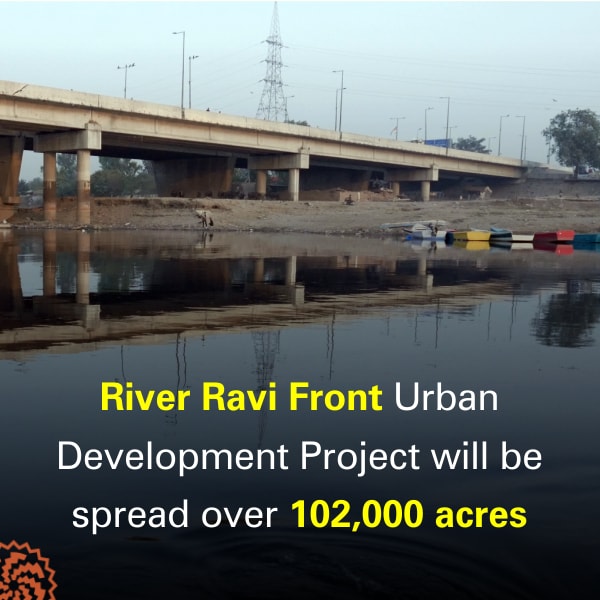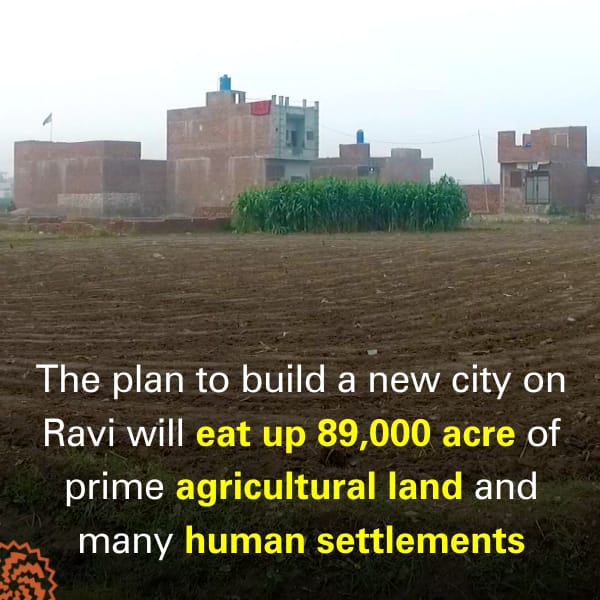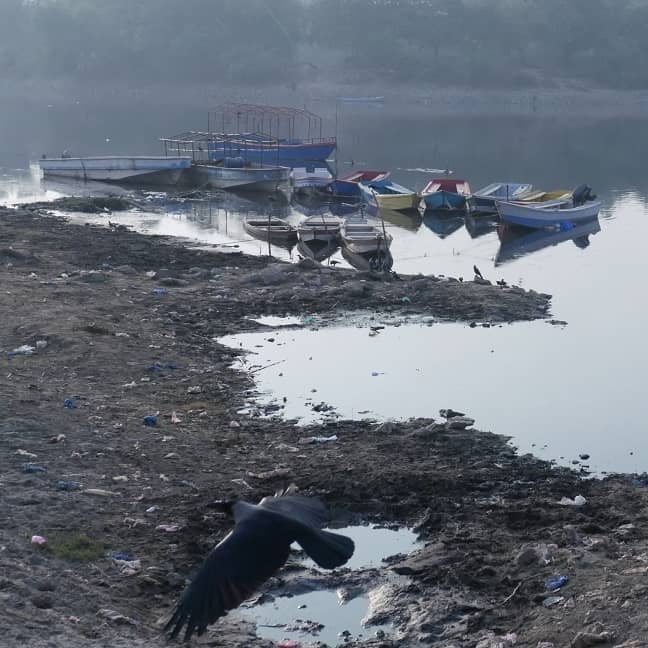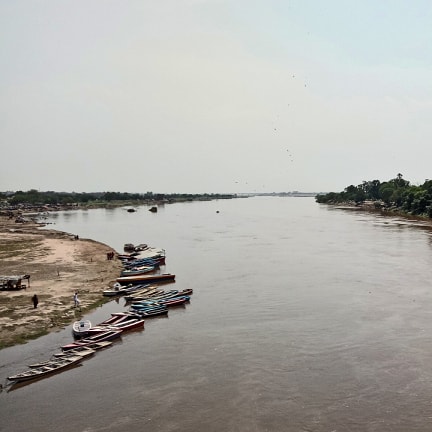Imagine an island with glittering waterfront skyscrapers, neat and clean boulevards, a large park with lush green lawns and white arches -- looking like a royal garden from the past -- where people of all ages are relaxing and socializing.
Now imagine that this island – spread over 2200 acres of land -- is located midst the blue waters of a river which is so clear that one can see fish and other river creatures swimming in it. Tall, dense trees line the riverbanks. Some people are enjoying boating in the water while others are looking at this amazing view from its artistically constructed bridges.
Someone familiar with the stinking garbage of a river called Ravi can never believe that it can house such an island but policymakers of the Punjab government think otherwise. They are certain that not only can they turn this heavenly view into an earthly reality but also can supplement it with all the facilities that a modern city requires. These include a residential project comprising 1.8 million housing units, a medical city spread over 5500 acres, a finance city built on 4000 acres and a knowledge city measuring more than 5000 acres of land – as well as sports and recreation facilities and eco-friendly agriculture farms.
This plan -- known as River Ravi Front Urban Development Project -- is going to have a total land area of 102,000 acres. It also involves the construction of three barrages on the river so that water flow can be regulated to protect it from floods.
Each of these barrages will be one kilometer long and 25 feet wide and together these will be able to stem the flow of water running at the speed of 586,000 cubic meters per second. This is being regarded as a safe capacity given that the fastest water flow in the Ravi for the last 89 years has been 500,000 cubic meters per second.
The first barrage will be built in Shahdara, near Mughal Emperor Jahangir’s tomb; the second will be constructed a few miles downstream where Lahore-Islamabad motorway passes above the river; and the third will be located even further downstream at Mohlanwal village.
Prime Minister Imran Khan inaugurated this project in September 2020. According to the government estimates, it will cost 5000 billion rupees. A large chunk of this amount will be private investments while the Punjab government will arrange the remaining funds from other sources.
The provincial government has already established a new entity -- Ravi Urban Development Authority -- to look after the administrative, legal and technical aspects of the project. The salaries and other perks and privileges being provided to the staff of this entity are coming entirely from the government’s resources.
Reality versus dreams
The Punjab government issued a notification on February 22nd, 2020 to authorize the Lahore Development Authority (LDA) to acquire private and public land for the project from around the river Ravi. It, however, withdrew this notification on October 6th. The official announcement of the withdrawal referred to a letter written by the chairman of the Ravi Urban Development Authority and a meeting presided by Prime Minister Imran Khan without giving any details of the two.
Many knowledgeable insiders, including Rafay Alam, a Lahore-based legal expert on environmental issues, are concerned that soon the government will issue another notification which will assign the power of land acquisition to the Ravi Urban Development Authority.

Whether these concerns materialize or not, the provincial government’s officials are busy marking houses and agricultural lands to be acquired for the project. Scores of thousands of people living in slums at the southern bank of the Ravi are extremely worried about this marking. Rukhsana Bibi, a 55-year-old woman, is one of them.
A resident of a settlement called Jhugian, she has six daughters and three sons and has been living in this settlement for the last eight years. Covered in a shawl but sitting barefoot at the door of her one-room house, she is looking very dejected. She has been running fever since the day the government officials came to her house and marked it for acquisition.
Her sons run a snack stall in a nearby village while her daughters pluck flowers and stitch garlands from them to sell in market. “My daughters have worked so hard that needles have made pores in their fingers. It was with such great effort that we managed to have a roof over our heads,” she says.
Jhugian is located on the right of the Ring Road if you are travelling from Lahore’s international airport towards Shahdara. Large swathes of agricultural land stretch from the settlement all the way to the bank of the river. Most of the people living here are laborers working in nearby industrial and commercial parts of Lahore – such as Misri Shah, Badaami Bagh, Laari Adda, Mewa Mandi and Sabzi Mandi.
The government officials are also marking private property for acquisition in two nearby settlements -- Bhumman and Khokhran.
Shabana Bibi, another resident of Jhugian, is also anxious about losing her house to the project. Her husband is a laborer and they could build their one and a half marla house after getting a bank loan. “We lived in a rented house for 21 year before moving into our own house and now (the government officials) are robbing us of what we have got after a huge effort,” she says as her voice chokes and tears fill her eyes.
Karamat Ali, 25, has a similar anxiety. He has only one hand and one foot and says that he has worked hard despite his disability as has his maidservant wife. “We did all this only to get a two-marla house for our children but now Imran Khan is saying that the government will demolish our house,” he tells Sujag.
He, however, is adamant that he will never let this happen. “The government will have to kill us all before demolishing our houses,” he says.
Zubaida Bibi, 55, expresses the same resolve. “I have suffered a lot for thirteen years to have my own house,” she says and warns the government that “I will never give up my house come what may”.
The death of a river foretold
Since the early 1990s, water flow has been decreasing in the Ravi. Simultaneously, the river has been attracting more real estate dealers than tourists and settlements have started to develop at its banks at a rapid speed. Some of these settlements have stretched themselves onto what once was the bed of the river itself.
In all this hullabaloo of buying and selling of land, most people have not bothered to check the ownership of the tracts of real estate purchased by them. Consequently, many people living in Jhugian and its neighboring settlements could not get the legally valid ownership rights of their houses. They might have paid millions of rupees to the self-claimed owners of the land but they are not sure if they can prove their ownership in a court of law.

That issue besides, the number of people living on and about the river has been increasing at such a brisk pace that it has reduced the Ravi to a dirty trickle.
Muhammad Manzoor has been working as a boatman for the last 32 years near a Mughal-era monument built inside the Ravi. He remembers how in 1988 a high flood in the river drowned many settlements on its banks. Although the river was much wider then as compared to what it is now, still the floodwater -- flowing at a speed of 300,000 cubic meters per second, spilled over and the government had to demolish the dykes on its northern bank so as to save the city of Lahore located on its southern bank. As a result of this, he says, “the road leading from Lahore to the town of Jaranwala went seven to eight feet under floodwater.”
Now that the river is much narrower than it was in the 1980s, even a smaller flood can cause massive destruction. Even if the chances of a flood are remote, the domestic and industrial waste flowing into the Ravi have made its water highly toxic for all forms of life. A report released in 2014 by the Worldwide Fund for Nature Pakistan has declared it the “most polluted river of Punjab” due to the poisonous effects of the waste mixing with its meager flow.
Several efforts have been made to clean the river in recent years but all of them have gone in vain.
According to a report released by the Asian Development Bank in 2009, the Punjab government conducted a study with financial assistance from the Japan International Corporation Agency (JICA), a donor organization associated with the government of Japan, to clean up the Ravi. The study stated that the task required an investment of 413 million US dollars (65.4 billion rupees in accordance with today’s currency prices). Likewise, another feasibility study conducted by a French consultant put the amount of the required investment at 118 million US dollars (or 18.7 billion rupees at the current currency rates).
The Lahore High Court, too, set up a commission in 2012 to rid the Ravi of pollution. This commission proposed that a floating island of plantation be installed in the river so that it could absorb all the toxic substances from its water.
Rafay Alam was a member of this commission. He says: “A study shows that the Ravi contains clean water – that also has aquatic life -- before it enters Lahore.” Instead of building a new city on the river, he says, it is this area upstream of Lahore that should be protected. Citing the study, he suggests that this area “should be converted into a national park to protect it from harmful environmental effects and no construction and industrial activities should be allowed there.”
Man proposes, money disposes
The plan to build a city on the Ravi is not new. Two previous governments have also tried to launch similar projects. In 2004-05, the Punjab government started acquiring land for a riverfront city but the residents of the area where land acquisition was being done protested so strongly against it that the government had to step back. Even more importantly, the government could not find the money needed for the project.
Also Read

The requiem of a dead river: Ravi's irreversible decline into a garbage dump
In 2013-14, another provincial administration hired Meinhardt, an engineering firm based in Singapore, to conduct a feasibility study for building an island city within the Ravi. The authors of the study stated that the project would require shifting the flow of the river to a new channel which alone needs 183 billion rupees, 10,901 acres of land and 30 years to complete.
Meinhardt also said that no one likes to live on a dry river so, to keep the Ravi flowing, it will be necessary for the project to bring in water from Upper Chinab and BRB canals. This water should flow at a minimum speed of 600 cubic meters per second. The firm, similarly, advised the government to set up multiple water treatment plants to clean up the residential, commercial and industrial sewage going into the river -- otherwise the condition of the river will remain as it is.
Even with these safeguards, the project will still have some disastrous environmental consequences. For instance, the proposed city will completely eliminate Annu Bhatti forest, one of three jungles near the Ravi, while half of another forest, krotana, will also be destroyed and there will be some partial damage to Shahdara forest as well. This project will also eat up 89,000 acre of prime agricultural land as well as many human settlements.
It was for all these reasons that the then government put the project on an indefinite hold.
This year, however, the incumbent provincial government has revived and revised the Meinhardt study and started an advertising campaign to inform the prospective investors about the project.
But Rafay Alam does not see these plans coming to fruition. He says, “If the government want to make the project possible then it needs water in the river but, according to the Indus Water Treaty, India has exclusive rights over the Ravi’s waters. The only solution to resolve this problem is to divert water reserved for irrigation to Ravi upstream of Lahore and then transfer it back into the canals system downstream from the city.”
He, though, warns that this type of water diversion requires huge financial investment. “Even if the government succeeds miraculously in securing that investment, it will still need to either stop all the sewerage water flowing into the Ravi or set up 12 water filtration plants to treat it so that the canal water coming into the river does not get polluted,” he says and adds that these plants alone will cost 500 billion rupees.”
It is because of these reasons -- and then some more – that Dr Kausar Abdullah Malik, who teaches botany at the F C College University in Lahore, considers the building of a city on the river as a project that will destroy the Ravi rather than reviving it. He has been the head of the Ravi commission set up by the Lahore High Court and believes that the sole purpose of this project is to sell and purchase land. “It is, in fact, a part of the incentives provided recently by the government to the construction industry,” he says and adds: “We, as a nation, are not interested in setting up any industry or any business. Instead, we only think that land and construction alone can provide us a path to progress.
This report was first published by Lok Sujag on 25 Nov 2020, on its old website.
Published on 4 Jun 2022


















